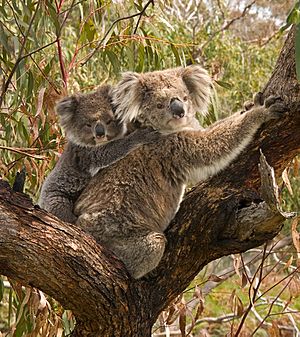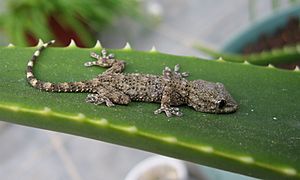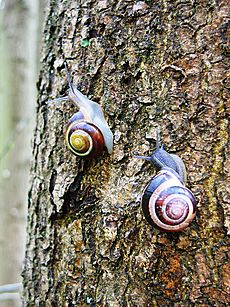Arboreal facts for kids
Arboreal means "living in trees." When we talk about animals, an arboreal animal is one that spends most of its life in trees. These animals have special ways of living and moving around in trees. One of the earliest known arboreal animals was Suminia, which lived about 260 million years ago.
Contents
How Animals Move in Trees
Living in trees can be tricky! Animals face many challenges when moving through branches. They need to be able to move on narrow branches, go up and down, keep their balance, cross gaps, and deal with things in their way. Animals have found many different ways to solve these problems.
Moving on Narrow Branches
Walking on a narrow branch is harder than walking on flat ground. On the ground, an animal's body can sway a bit. But on a narrow branch, if the body sways too much, the animal could fall off! Also, animals have to be careful where they place their feet to stay on the branch. This means they can't move in as many ways as they could on the ground.
Going Up and Down Branches
Branches often point up or down, not just straight across. Moving up a slanted branch means fighting gravity, which makes it harder. Going down is also tough because the animal has to control its speed to avoid falling. Many animals that live in trees have special ways to climb down safely.
Keeping Your Balance in Trees
Because branches are often high up, falling can be very dangerous. So, keeping balance is super important for arboreal animals. On flat or gently sloped branches, the main problem is tipping over sideways. The narrower the branch, the harder it is to balance. On steep branches, tipping is less of an issue. Instead, animals might slip or fall backward.

Crossing Gaps Between Branches
Trees don't have continuous branches. Arboreal animals need to get from one branch to another, or even from one tree to another. They can do this by reaching across gaps, leaping over them, or even gliding through the air.
Dealing with Obstacles in Trees
Tree habitats are full of things that can get in the way, like other branches sticking out. These obstacles can make it hard to move. But animals can also use them as extra places to hold on to, which helps them move better. While branches might slow down animals with limbs, they actually help snakes by giving them places to push off from.
Special Body Parts for Tree Life
Arboreal animals have many special body parts that help them deal with the challenges of living in trees.
Long Limbs for Reaching
Many tree-dwelling animals have long arms and legs. These long limbs help them reach across gaps, grab fruit, check if a branch is strong enough, and even swing from branch to branch. However, some lizards have shorter limbs, which helps them move without branches getting in their way.
Tails That Can Grab
Many arboreal animals use their tails to grab onto branches. Animals like tree porcupines, chameleons, silky anteaters, spider monkeys, and possums have what are called "prehensile tails." This means their tails can act like an extra hand. Some, like the spider monkey, even have a bare or sticky patch at the tip of their tail for better grip.
Claws for Grip
Claws are great for holding onto rough surfaces. This is how squirrels can climb straight up tree trunks, even though the trunks are huge compared to them. However, claws can sometimes make it hard to grip very small branches, as they might wrap too far around and poke the animal's own paw.
Sticky Feet for Smooth Surfaces
Some animals use sticky pads on their feet instead of claws, which works best on smooth surfaces. Tree frogs and arboreal salamanders often have wet, sticky feet that work like suction cups or use tiny water forces to stick. Geckos are famous for their dry sticky toes. They use tiny forces called van der Waals forces to stick to almost any surface, even glass!
Gripping with Fingers and Toes
Many primates, like monkeys, use their hairless fingertips to grip branches. They squeeze the branch between their fingers, creating friction that holds their hand firmly. However, this type of grip works better on smaller branches. Other animals, like chameleons, have mitten-like feet for grasping, and many birds grip branches when they perch or move around.
Feet That Can Turn Around
To help them climb down, especially on large branches, some arboreal animals like squirrels have very flexible ankle joints. They can turn their feet almost backward. This allows their claws to hook into the rough bark, helping them hold on against gravity.
Lowering Their Center of Mass
Many tree-dwelling animals lower their center of mass (their balance point) to stop themselves from tipping or falling when climbing. They might do this by changing their posture, having different body shapes, or simply by being smaller.
Being Small Helps a Lot
Being small gives many advantages to animals living in trees. It makes the branches seem bigger compared to the animal, lowers their balance point, makes them more stable, and means they weigh less (so they can move on smaller branches). Smaller animals can also move through very crowded parts of the habitat.
Hanging Under Branches
Some animals, like certain primates, bats, and all sloths, hang underneath branches. This gives them great stability. If they hang, they don't have to worry about tipping or falling backward; the only way they'd fall is if they lost their grip.
Special Behaviors for Tree Life
Arboreal animals also have special ways of behaving when they move in trees, especially in how they stand and walk. For example, tree-dwelling mammals often take longer steps, stretch their limbs further, crouch down to lower their balance point, and use a specific walking pattern called a diagonal sequence gait.
Why Living in Trees Matters
Moving in trees allows animals to find different food and resources. Larger animals might only be able to use bigger branches that can hold their weight. Smaller animals can avoid competing with larger ones by moving on narrower branches.
Climbing Without Trees
Many animals climb in other places, like on rocks or mountains. In these places, many of the same challenges apply, such as steep slopes, narrow ledges, and balance problems. However, we don't know as much about how animals move in these specific habitats.
Some of the most amazing climbers on steep or even almost vertical rock faces are mountain-dwelling animals like Barbary sheep, markhor, yak, ibex, tahr, Rocky Mountain goat, and chamois. They have special hooves with soft, rubbery pads for grip and sharp edges for holding onto small footholds. The snow leopard, which hunts these mountain animals, also has incredible balance and can leap very far, sometimes up to 17 meters (about 50 feet)! Other great balancers and leapers include the mountain zebra, mountain tapir, and hyraxes.
Swinging Through Trees (Brachiation)
Brachiation is a very special way of moving through trees. It's used by some primates to move super fast while hanging underneath branches. It means swinging with your arms from one handhold to another. Only a few species are brachiators, and they are all primates. It's a main way of moving for spider monkeys and gibbons, and female orangutans sometimes use it too. Gibbons are the true experts at this. They can swing from branch to branch over distances of up to 15 meters (50 feet) and travel as fast as 56 kilometers per hour (35 mph)!
Gliding and Parachuting
To get across gaps between trees, many animals like the flying squirrel have special skin flaps called patagia that let them glide through the air. Some animals can slow down their fall using a method called parachuting. For example, Rhacophorus, a "flying frog" species, has special toe membranes that help it fall more slowly after jumping from trees.
Climbing Without Limbs
Many types of snakes live in trees, and some have special muscles for this habitat. When moving on bare branches, snakes move slowly using a special "concertina" motion. But when there are other branches sticking out, snakes use a faster, wavy motion. This means snakes do best on small branches in crowded areas, while animals with limbs seem to do better on large branches in open areas.
Some Arboreal Animals
Many, many animals live in trees. Here is a list of some well-known or mostly tree-dwelling animals:
- Primates (like monkeys and apes)
- Cats (some types)
- Brushtail possums
- Opossums
- Sloths
- Anteaters
- Treeshrews
- Goats (some wild types)
- Colugos (also known as "flying lemurs")
- Kinkajous
- Viverrids (like civets and genets)
- Tree squirrels and many other rodents
- Parrots
- Geckos
- Chameleons
- Many other lizards
- Mambas
- Brown Tree Snakes
- Many other snakes
- Stick insects
- Many other arthropods (like insects and spiders)
- Tree snails
- Koalas
See also
 In Spanish: Arborícola para niños
In Spanish: Arborícola para niños





